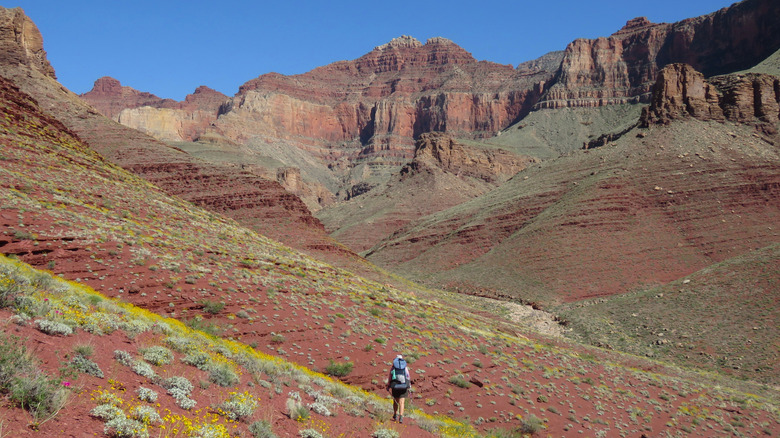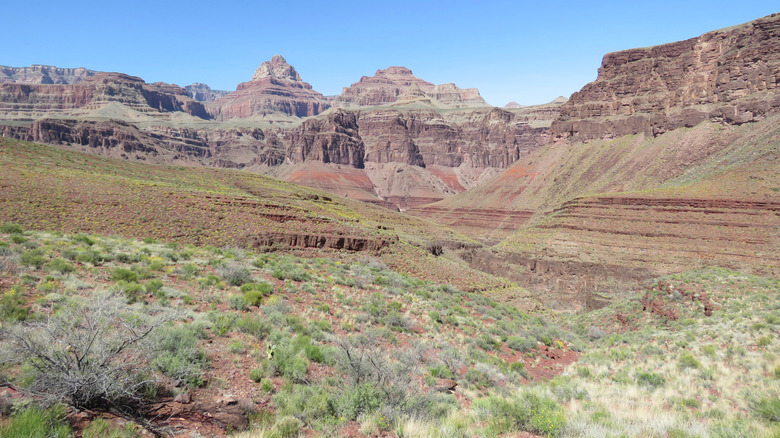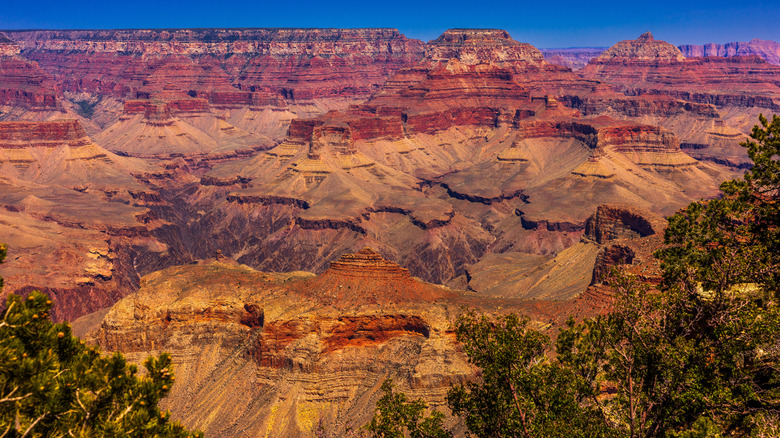Solitude In The Grand Canyon Really Is Possible On This Less-Traveled, Beautiful Backcountry Route
The Grand Canyon is one of the most well-known natural wonders in the world, but due to its popularity, many of the vantage points are often overcrowded. However, for those seasoned backpackers who may have already walked down the Canyon's most well-trodden paths, The Escalante Route offers a secluded and rewarding experience off the beaten track. This 32-mile backcountry trek is the best way to get to know some of the national park's most remote and breathtaking sections. Combing terrain along the Colorado River, this route will take you deep into the canyon, away from the crowds and into the epicenter of its untamed wilderness.
Starting at the South Rim, known to be one of the best places at the Grand Canyon for hiking, this trail is not for the faint-hearted, as hiking the Escalante Route is a journey of physical endurance, but also a full immersion into one of the world's most impressive natural wonders. For those looking for challenge, solitude and untapped, awe-inspiring natural beauty, this trail proves that seclusion in the Grand Canyon is not just possible, but is also incredibly rewarding.
The Escalante Route, a journey into the unknown
Starting at Tanner Trailhead, you'll begin the descent from the South Rim into the Canyon. This trail quickly drops in elevation, exposing incredible views of the Grand Canyon's layered rock formations and views of the Colorado River below. As you make your way down, you'll see the terrain transition from desert land to a more rocky, rugged environment. The descent will take you to the Colorado River's turquoise waters where the Escalante Route begins.
Once at the beginning of this trail, you'll head toward the river for about 9 miles and hike along it for around 10 miles. Though this section of the trail is physically demanding, as it includes exposed cliffside paths and rocky terrain, it is also mesmerizing. Some of the highlights of this section are Seventy Mile Creek and Slot Canyon, a narrow canyon carved by centuries of erosion with twisting walls that create a maze-like passageway. As you continue along the river, you'll reach the Hance Rapids, some of the most powerful rapids in the Grand Canyon, a real tour de force.
After this you'll face one of the largest challenges of the Escalante Route, climbing the Papago Wall. An almost vertical, roughly 30-foot rock face that requires some scaling. Though the ascent is short, climbing skills are required. Immediately after this, you'll encounter the Papago Slide, a steep descent that is as tough as the climb! Once you've completed this tough challenge, you'll be greeted with iconic red rock formations and experience one of the most serene parts of the canyon. The final ascent of the journey is at the Grandview Trail, where you'll walk the footsteps of copper miners to reach the South Rim once more. From the top, hikers can see the miles of terrain they've traversed, appreciating the challenges they've undertaken to get there.
Solitude within the magnitude of the Grand Canyon
Beginning at Tanner Trailhead, The Escalante Route is found on the Southern border of the Grand Canyon National Park, ending at the Grandview Trailhead. You can reach the route from Flagstaff, Arizona by driving along Highway 180 North for 80 miles to the South Rim Entrance. From there, go along Desert View Drive (State Route 64) to Lipan Point where Tanner Trailhead begins. If you're traveling by air, the largest major airport is Flagstaff Pulliam Airport, about 90 minutes away from the South Rim. You can also reach the trailhead via shuttle from Phoenix, Flagstaff, and Grand Canyon Village, but driving is recommended. Since the Escalante Route is one-way, hikers should consider transportation back to their vehicle at the end of the trek. Parking is available at Grandview Point.
Hiking in The Grand Canyon National Park is best done during the months of September, October, and November when temperatures are less extreme. Due to its remote nature, the Escalante Route is recommended for serious backpackers with a good knowledge of navigation. Water sources are limited, so careful planning is required to avoid problems or danger along the way, as parts of the park can be perilous. For overnight camping trips, a permit is required from the Grand Canyon National Park's Backcountry Information Center. Make sure to carry sufficient food and drink before heading out on the trail and be prepared for weather changes. For those brave enough to take on these challenges, the Escalante Route is one of the most rewarding and secluded backpacking experiences the Grand Canyon has to offer, showcasing some of the most untouched landscapes in the park.


